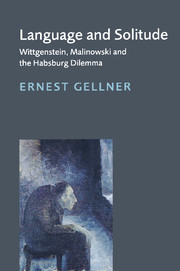Book contents
- Frontmatter
- Contents
- Preface
- Foreword
- Part I The Habsburg dilemma
- Part II Wittgenstein
- 10 The loneliness of the long-distance empiricist
- 11 The poem to solitude, or: confessions of a transcendental ego who is also a Viennese Jew
- 12 Ego and language
- 13 The world as solitary vice
- 14 The mystical
- 15 The central proposition of the Tractatus: world without culture
- 16 Wittgenstein mark 2
- 17 Tertium non datur
- 18 Joint escape
- 19 Janik and Toulmin: a critique
- 20 The case of the disappearing self
- 21 Pariah communalism
- 22 Iron cage Kafka-style
- Part III Malinowski
- Part IV Influences
- Part V Conclusions
- General bibliography
- Bibliographies of Ernest Gellner's writings on Wittgenstein, Malinowski, and nationalism
- Index
16 - Wittgenstein mark 2
Published online by Cambridge University Press: 05 March 2010
- Frontmatter
- Contents
- Preface
- Foreword
- Part I The Habsburg dilemma
- Part II Wittgenstein
- 10 The loneliness of the long-distance empiricist
- 11 The poem to solitude, or: confessions of a transcendental ego who is also a Viennese Jew
- 12 Ego and language
- 13 The world as solitary vice
- 14 The mystical
- 15 The central proposition of the Tractatus: world without culture
- 16 Wittgenstein mark 2
- 17 Tertium non datur
- 18 Joint escape
- 19 Janik and Toulmin: a critique
- 20 The case of the disappearing self
- 21 Pariah communalism
- 22 Iron cage Kafka-style
- Part III Malinowski
- Part IV Influences
- Part V Conclusions
- General bibliography
- Bibliographies of Ernest Gellner's writings on Wittgenstein, Malinowski, and nationalism
- Index
Summary
One of the commonest, oft-repeated remarks made about Wittgenstein is that he worked out and was famous for not one, but two philosophies. The first was contained in his Tractatus, and the latter in a long, seemingly unending stream of posthumous publications, but above all in his Philosophical Investigations (1953).
It is not clear precisely which of the many possible deficiencies of his first position persuaded him that it was untenable. Perhaps it does not even matter too much. Something or other persuaded him, and even that only in a certain limited sense, that his initial position was indeed misguided. The limited sense is important, because it is fairly obvious that he continued to believe that if philosophy in the old sense were possible at all, then indeed his early philosophy would be the correct and only possible version of it. The philosophical options of humanity were limited: it could choose the views of his youth or those of his middle age …
In order to move to his second position, the one which is held to represent his mature views, those destined to secure him enormous influence, two, and only two, premises were required. One was: his early universalistic/individualist views, articulated on the basis of the idea that modern logic and its notation revealed the hidden structure of thought and meaning, were mistaken. Precisely why he reached this conclusion remains something of a mystery. I feel I can guess his motives, but not his reasons. The motives are more important.
- Type
- Chapter
- Information
- Language and SolitudeWittgenstein, Malinowski and the Habsburg Dilemma, pp. 71 - 73Publisher: Cambridge University PressPrint publication year: 1998



